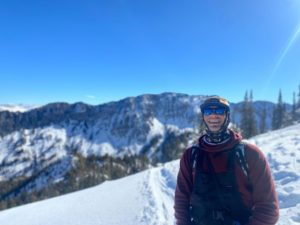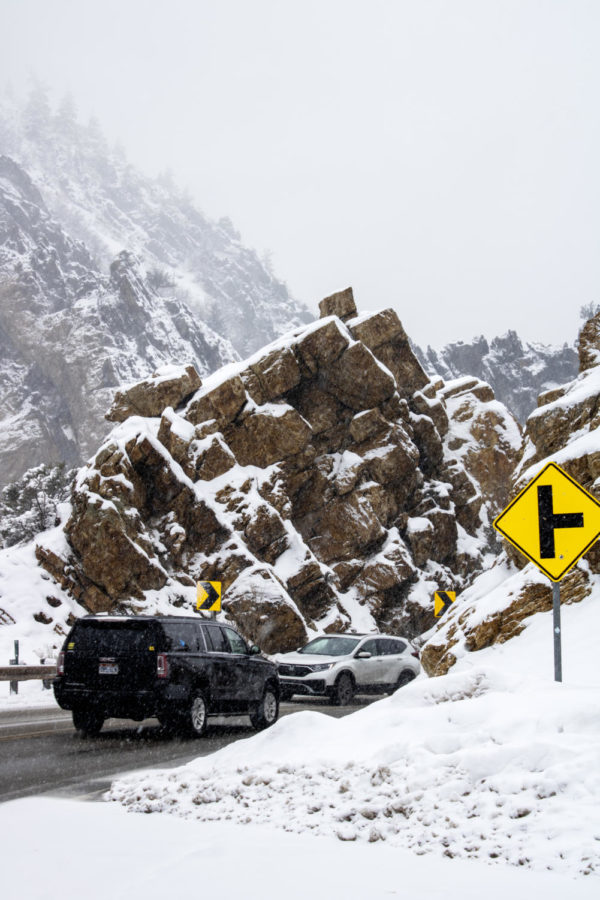A Rare Moment of Silence in the Canyons
Have you ever driven up Big Cottonwood Canyon in the winter ready for a great day of deep turns, face shots, getting sendy, blasting music, downing Red Bulls, and joking around with friends when, all of a sudden, the car goes silent? The radio is muted, conversations halt, and you may even hold your breath. You pass through a large, sharp rock on your left and a red cliff face on your right. ‘What is going on?’ you wonder, ‘Why did the mood change so rapidly?’ Then, just as quick as it left and before you can get a question out, sound fills the car and you’re focused, once again, on the ski day ahead.
There is no shortage of superstition, traditions, and lore within sports and the outdoors. It’s common to repeat wearing items of clothing after a successful day, have a lucky jersey number, or have a calculated ritual of playlists, meals, sayings, etc. Skiing is no exception to this with many traditions that have become widespread.
One universal superstition is the refusal to call last run. As it goes, calling last run will increase your chance of injury. Rather, you would call it a “two skip.” Others include pole whacking, ski burning, and putting ski boots on in the same order. As widespread as some customs get, there are also some that are localized. In the Wasatch, Silent Curve is one of those.
Silent Curve (which is also sometimes called silent turn and/or silent rock) is a portion of road in Big Cottonwood Canyon where the road cuts through a section of the mountain located near Storm Mountain Picnic Area. It has become a fairly common tradition – and somewhat a superstition – for many canyon goers to become silent as they drive through Silent Curve.
The general consensus of this area is that talking, being loud, playing music, etc. as your vehicle passes through the area will bring misfortune and bad luck to your day. And there is no shortage of passionate believers in this tradition. Ask around at one of the local resorts and you are bound to hear of someone who has suffered as a result of their disregard of the tradition.
Many people – including myself – observe this tradition of silence around the corner, but the reasons and origins behind it have become somewhat hazy. Ask any skier about it, and you’re bound to get a multitude of responses because no one knows for certain. Every skier has different interpretations and impressions on how it came to be, making it nearly impossible to pinpoint. However, there have been several prominent theories of the origins.
One of the most common threads that come up – and what I was first told when I learned of this – is that this is a way to honor the dead. Different details and accounts revolve around this explanation. One description mentions that many vehicle crashes and subsequent deaths have occurred at the spot over the years. Specific stories of this are often unknown, but entirely believable seeing how icy the area gets in the winter. The other explanation indicates road workers who reportedly died during the original construction of Big Cottonwood Canyon and Guardsman Pass. Both of these recollections provide compelling arguments for most people not to talk around the corner but are not the only motives that have been widely spread and accepted over the years.
A common alternative philosophy for the tradition is that one’s silence is a way to show respect to nature. As mentioned earlier, at Silent Curve, the mountain was cut into to make way for the road. So, it is important to express gratitude and admiration for the mountain and nature as a whole. In a sense, it is a way for you to “pay your dues” after the mountain has given so much, a way for many to instill a healthy respect for the mountains in future generations, and a way for us to be reminded of the power of nature and to not get caught up in all the fun.
Lastly, there are deductions that say the tradition was adopted from Mt. Hood that has since spread to the Wasatch or that it was some clever device to get drivers to focus on the road during a more dangerous segment. Valid as they may be, these are less popular within Utah ski culture.
Whatever reason you may subscribe to, Silent Curve, in one way or another, has evolved into an easy and fun way for anyone to engage with ski culture and all the whacky stuff it brings. And in a world where more and more are being gatekept, that is precious. So next time you find yourself traveling up Big Cottonwood Canyon and passing through Silent Curve, turn down your radio; if not to avoid misfortune, then because ski culture is alive and well in Utah and you are invited into it.



